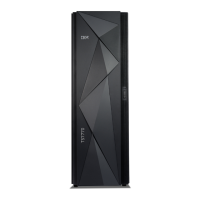August 15, 2017
© Copyright IBM Corporation, 2017 Page 80 of 117
Management Class: MCCEDATA
- Secondary Pool: 8
- Cluster 0 Copy Policy: RUN
- Cluster 1 Copy Policy: RUN
You would also define this same management class on cluster 0 without specifying a secondary pool.
To ensure that the export list file volume gets written to cluster 1 and only exists there, you would define a
management class, for example, of MCELFVOL, on cluster 1 as follows:
Management Class: MCELFVOL
- Cluster 0 Copy Policy: No Copy
- Cluster 1 Copy Policy: RUN
You would also define this management class on cluster 0 as follows:
Management Class: MCELFVOL
- Cluster 0 Copy Policy: No Copy
- Cluster 1 Copy Policy: RUN
A copy export operation can be initiated through any virtual tape drive in the TS7700 Grid configuration; it
does not have to be initiated on a virtual drive address in the TS7700 that is to perform the copy export
operation. The operation will be internally routed to the TS7700 that has the valid copy of the specified
export list file volume. Operational and completion status will be broadcast to all hosts attached to all of the
TS7700s in the Grid configuration.
Only the logical volumes resident on the TS7700 performing the operation, at the time it is initiated, are
exported. If a logical volume has not been copied yet or completed its copy operation when the export
operation is initiated, it is not considered for export during the operation. It is assumed that copy export is
performed on a regular basis and logical volumes, whose copies were not complete when a copy export was
initiated, will be exported the next time copy export is initiated. You can check the copy status of the logical
volumes on the TS7700 that is to perform the copy export operation prior to initiating the operation by using
the Volume Status function of the BVIR facility. You can then be sure that all critical volumes will be
exported during the operation.
The next has to do with how copy export recovery is performed. Copy export recovery is always to a
standalone TS7700. As part of the recovery process, the recovery TS7700 will process all grid related
information in the database converting it to look like a single TS7700. This means that the recovery TS7700
will have volume ownership of all volumes. It is possible that one or more logical volumes will become
inaccessible because they were modified on a TS7700 other than the one that performed the copy export
operation and the copy did not complete prior to the start of the operation.
The last has to do with returning copy exported physical volumes when they are empty. Remember that each
copy exported physical volume remains under the management of the TS7700 that it was exported from.
Normally, you would return the empty physical volumes to the library I/O station associated with the source
TS7700 and re-insert them. They would then be reused by that TS7700. If you want to move them to
another TS7700 whether in the same Grid configuration or another, keep two things in mind. First, you
would need to ensure that the volser ranges you had defined for that TS7700 matches the volsers of the
physical volume(s) you want to move. And second, you will need to use the host console request function,

